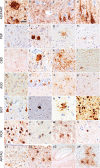A walk through tau therapeutic strategies
- PMID: 30767766
- PMCID: PMC6376692
- DOI: 10.1186/s40478-019-0664-z
A walk through tau therapeutic strategies
Abstract
Tau neuronal and glial pathologies drive the clinical presentation of Alzheimer's disease and related human tauopathies. There is a growing body of evidence indicating that pathological tau species can travel from cell to cell and spread the pathology through the brain. Throughout the last decade, physiological and pathological tau have become attractive targets for AD therapies. Several therapeutic approaches have been proposed, including the inhibition of protein kinases or protein-3-O-(N-acetyl-beta-D-glucosaminyl)-L-serine/threonine Nacetylglucosaminyl hydrolase, the inhibition of tau aggregation, active and passive immunotherapies, and tau silencing by antisense oligonucleotides. New tau therapeutics, across the board, have demonstrated the ability to prevent or reduce tau lesions and improve either cognitive or motor impairment in a variety of animal models developing neurofibrillary pathology. The most advanced strategy for the treatment of human tauopathies remains immunotherapy, which has already reached the clinical stage of drug development. Tau vaccines or humanised antibodies target a variety of tau species either in the intracellular or extracellular spaces. Some of them recognise the amino-terminus or carboxy-terminus, while others display binding abilities to the proline-rich area or microtubule binding domains. The main therapeutic foci in existing clinical trials are on Alzheimer's disease, progressive supranuclear palsy and non-fluent primary progressive aphasia. Tau therapy offers a new hope for the treatment of many fatal brain disorders. First efficacy data from clinical trials will be available by the end of this decade.
Keywords: Aggregation; Alzheimer’s disease; Immunotherapy; PET imaging; Tau vaccines; Tauopathies; Therapeutic interventions.
Conflict of interest statement
Competing interests
SJ, RS, EK and NZ are Axon Neuroscience R&D Services employees. LB received research grants from UCB Biopharma. Other authors declare that they have no competing interests.
Publisher’s Note
Springer Nature remains neutral with regard to jurisdictional claims in published maps and institutional affiliations.
Figures






Similar articles
-
Tau immunotherapy for Alzheimer's disease.Trends Mol Med. 2015 Jun;21(6):394-402. doi: 10.1016/j.molmed.2015.03.003. Epub 2015 Apr 3. Trends Mol Med. 2015. PMID: 25846560 Review.
-
An Overview on the Clinical Development of Tau-Based Therapeutics.Int J Mol Sci. 2018 Apr 11;19(4):1160. doi: 10.3390/ijms19041160. Int J Mol Sci. 2018. PMID: 29641484 Free PMC article. Review.
-
Tau immunotherapy in Alzheimer's disease and progressive supranuclear palsy.Int Immunopharmacol. 2022 Dec;113(Pt B):109445. doi: 10.1016/j.intimp.2022.109445. Epub 2022 Nov 18. Int Immunopharmacol. 2022. PMID: 36410182 Review.
-
Clinical development of passive tau-based immunotherapeutics for treating primary and secondary tauopathies.Expert Opin Investig Drugs. 2023 Jul-Dec;32(7):625-634. doi: 10.1080/13543784.2023.2233892. Epub 2023 Jul 10. Expert Opin Investig Drugs. 2023. PMID: 37405389 Review.
-
Tau Proteins and Tauopathies in Alzheimer's Disease.Cell Mol Neurobiol. 2018 Jul;38(5):965-980. doi: 10.1007/s10571-017-0574-1. Epub 2018 Jan 3. Cell Mol Neurobiol. 2018. PMID: 29299792 Review.
Cited by
-
Bridging Scales in Alzheimer's Disease: Biological Framework for Brain Simulation With The Virtual Brain.Front Neuroinform. 2021 Apr 1;15:630172. doi: 10.3389/fninf.2021.630172. eCollection 2021. Front Neuroinform. 2021. PMID: 33867964 Free PMC article. Review.
-
NMR Studies of Tau Protein in Tauopathies.Front Mol Biosci. 2021 Nov 11;8:761227. doi: 10.3389/fmolb.2021.761227. eCollection 2021. Front Mol Biosci. 2021. PMID: 34859051 Free PMC article. Review.
-
Extracellular tau stimulates phagocytosis of living neurons by activated microglia via Toll-like 4 receptor-NLRP3 inflammasome-caspase-1 signalling axis.Sci Rep. 2023 Jul 4;13(1):10813. doi: 10.1038/s41598-023-37887-3. Sci Rep. 2023. PMID: 37402829 Free PMC article.
-
Potent Tau Aggregation Inhibitor D-Peptides Selected against Tau-Repeat 2 Using Mirror Image Phage Display.Chembiochem. 2021 Nov 3;22(21):3049-3059. doi: 10.1002/cbic.202100287. Epub 2021 Sep 12. Chembiochem. 2021. PMID: 34375027 Free PMC article.
-
Neuronal Vulnerability of the Entorhinal Cortex to Tau Pathology in Alzheimer's Disease.Br J Biomed Sci. 2024 Oct 7;81:13169. doi: 10.3389/bjbs.2024.13169. eCollection 2024. Br J Biomed Sci. 2024. PMID: 39435008 Free PMC article. Review.
References
-
- Agadjanyan MG, Zagorski K, Petrushina I, Davtyan H, Kazarian K, Antonenko M, Davis J, Bon C, Blurton-Jones M, Cribbs DH, Ghochikyan A. Humanized monoclonal antibody armanezumab specific to N-terminus of pathological tau: characterization and therapeutic potency. Mol Neurodegener. 2017;12:33. doi: 10.1186/s13024-017-0172-1. - DOI - PMC - PubMed
-
- Ahmed T, Blum D, Burnouf S, Demeyer D, Buee-Scherrer V, D'Hooge R, Buee L, Balschun D (2015) Rescue of impaired late-phase long-term depression in a tau transgenic mouse model. Neurobiol Aging 36:730–739. 10.1016/j.neurobiolaging.2014.09.015 - PubMed
Publication types
MeSH terms
Substances
Grants and funding
LinkOut - more resources
Full Text Sources
Other Literature Sources

